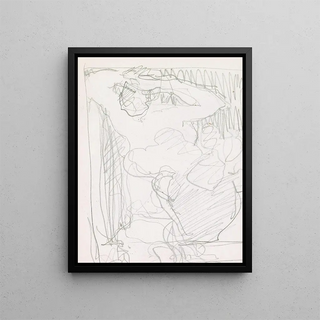Art print | Figure study - Reijer Stolk


View from behind

Frame (optional)
Art print Study of Figure - Reijer Stolk – Captivating Introduction
The artwork "Study of Figure - Reijer Stolk" is part of an artistic tradition that celebrates the beauty of the human body and the complexity of postures. Through this study, the artist manages to capture not only the form but also the very essence of the being, inviting the viewer to a deep contemplation. The finesse of the lines and the delicacy of the proportions reveal remarkable technical skill, bearing witness to an era when the art of human representation was at its peak. This piece, far more than a simple study, becomes an open window into the human soul, a reflection of the emotions and thoughts that inhabit each figure.
Style and uniqueness of the work
The style of "Study of Figure - Reijer Stolk" is distinguished by meticulous attention to detail and an almost sculptural approach to representation. The lines are fluid, and the subtly placed shadows give life to the silhouette, creating a play of light that emphasizes the three-dimensionality of the body. The artist uses a palette of soft tones, contributing to the overall harmony of the piece. Every curve, every muscle is carefully observed, demonstrating a deep understanding of human anatomy. This striking realism is accompanied by a certain poetry, where the beauty of movement and the expression of feelings meet. Thus, the work is not limited to a simple academic exercise but becomes a true celebration of life and art.
The artist and his influence
Reijer Stolk, an emblematic figure of his time, managed to leave a mark on the art world with his innovative approach and attention to detail. Influenced by the great masters of the Renaissance and Baroque, he reinterpreted the codes of representation while infusing his own sensitivity. His work demonstrates a profound respect for tradition while seeking to explore new perspectives. The way he approaches the human figure has inspired many contemporary artists, who see in him a model of excellence. His work also contributed to enriching the dialogue between classical art and modern movements, laying the groundwork for reflection on the place of the human figure in art.
A wall decoration of

Matte finish

View from behind

Frame (optional)
Art print Study of Figure - Reijer Stolk – Captivating Introduction
The artwork "Study of Figure - Reijer Stolk" is part of an artistic tradition that celebrates the beauty of the human body and the complexity of postures. Through this study, the artist manages to capture not only the form but also the very essence of the being, inviting the viewer to a deep contemplation. The finesse of the lines and the delicacy of the proportions reveal remarkable technical skill, bearing witness to an era when the art of human representation was at its peak. This piece, far more than a simple study, becomes an open window into the human soul, a reflection of the emotions and thoughts that inhabit each figure.
Style and uniqueness of the work
The style of "Study of Figure - Reijer Stolk" is distinguished by meticulous attention to detail and an almost sculptural approach to representation. The lines are fluid, and the subtly placed shadows give life to the silhouette, creating a play of light that emphasizes the three-dimensionality of the body. The artist uses a palette of soft tones, contributing to the overall harmony of the piece. Every curve, every muscle is carefully observed, demonstrating a deep understanding of human anatomy. This striking realism is accompanied by a certain poetry, where the beauty of movement and the expression of feelings meet. Thus, the work is not limited to a simple academic exercise but becomes a true celebration of life and art.
The artist and his influence
Reijer Stolk, an emblematic figure of his time, managed to leave a mark on the art world with his innovative approach and attention to detail. Influenced by the great masters of the Renaissance and Baroque, he reinterpreted the codes of representation while infusing his own sensitivity. His work demonstrates a profound respect for tradition while seeking to explore new perspectives. The way he approaches the human figure has inspired many contemporary artists, who see in him a model of excellence. His work also contributed to enriching the dialogue between classical art and modern movements, laying the groundwork for reflection on the place of the human figure in art.
A wall decoration of






